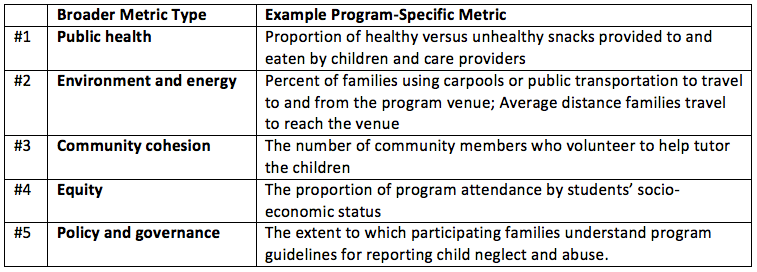Kara Crohn and Matt Galport here – we’re consultants with EMI Consulting, an evaluation and consulting firm based in Seattle, Washington that focuses on energy efficiency and renewable energy programs and policies. More than ever, evaluators must consider how their clients’ programs impact the well-being of the communities and environments in which they are embedded. It is also important for evaluators to consider how their clients’ program goals relate to state, national, or global sustainability goals. In this post, we offer five types of systems-oriented sustainability metrics that evaluators can use to connect clients’ program contributions to broader environmental, economic, health, and social metrics of well-being.
But first, what do we mean by “sustainability”?
In this post, we’re not talking about the longevity of the program, but rather the extent to which a program’s outcomes, intended or otherwise, contribute to or detract from the future well-being of its stakeholders. We are also using an expanded definition of “stakeholders” that includes communities and environmental resources affected by the program.
Hot Tip:
Consider incorporating these five types of sustainability metrics into your next evaluation:
#1: Public health: The extent to which a program contributes to or detracts from the health of program and community stakeholders
#2: Environment and energy: The extent to which a program implements environmental and energy conservation policies that support resource conservation
#3: Community cohesion: The extent to which a program promotes or detracts from the vibrancy and trust of the communities in which it is embedded
#4: Equity: The extent to which a program contributes to or detracts from fair and just distribution of resources
#5: Policy and governance: The extent to which a program’s policies support civil society, democratic institutions, and protect the disadvantaged
So, what would this look like in practice?
Here’s an example of how to connect program-specific metrics for a small, local after-school tutoring program to the broader set of social goals.
Rad Resources:
Resources for municipal and global sustainability metrics:
Municipal: STAR Rating system for U.S. cities
Global: United Nation’s Sustainable Development Goals
Continue the conversation with us! Kara kcrohn@emiconsulting.com and Matt mgalport@emiconsulting.com.
The American Evaluation Association is celebrating Environmental Program Evaluation TIG Week with our colleagues in the Environmental Program Evaluation Topical Interest Group. The contributions all this week to aea365 come from our EPE TIG members. Do you have questions, concerns, kudos, or content to extend this aea365 contribution? Please add them in the comments section for this post on the aea365 webpage so that we may enrich our community of practice. Would you like to submit an aea365 Tip? Please send a note of interest to aea365@eval.org. aea365 is sponsored by the American Evaluation Association and provides a Tip-a-Day by and for evaluators.


Compare your five metrics with this “greenprint” for green schools by the Green Schools National Network: https://greenschoolsnationalnetwork.org/green-print/ .
Best,
Chad
Compare your five metrics with this “greenprint” for green schools by the Green Schools National Network: https://greenschoolsnationalnetwork.org/green-print/ .
Best,
Chad
I do agree that the tips given about the five types of sustainability metrics cannot be applied to all evaluations, since different culture and country would not have the same situation. The deep rural areas of a country would not necessarily share the same values as an uptown urbanized area. In analyzing the five types of metrics purported by Crohn and Galport this will assist the researcher to prepare and execute program in order to achieve the desired outcome.